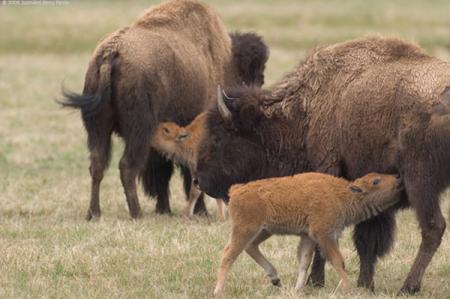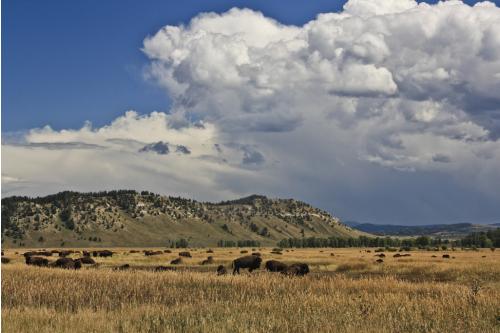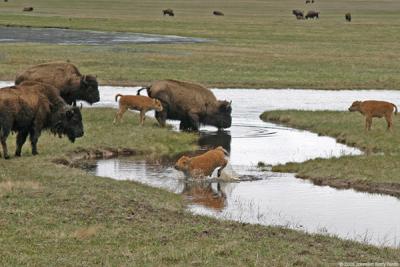
Yellowstone National Park is America’s oldest – and perhaps most iconic – national park. It is also home to many large mammals, including elk, wolves, moose, bears and bison, the charismatic megafauna of the American West. The bison here are part of the largest and likely oldest bison herd in the world. American bison, or buffalo, as they are colloquially called, were once present in the millions, possibly the most abundant large land mammal on earth. The Yellowstone herd is unique genetically and behaviorally, as they have continuously roamed free on the Great Plains since their ancestors arrived 50 million years ago and are generally considered to be the only surviving genetically pure herd.

But this unique and only free-roaming bison population is once again under threat. Wild bison are supposed to be protected in national parks, allowed to explore and feed and inspire visitors and scientists and artists. Unfortunately, the mismanagement of the rare herd in Yellowstone is shameful and could prove catastrophic for the last bastion of wild bison.
During the 1990s, the bison population increased under the protections of the Department of the Interior, but due to the limited space inside the park and the increasing pressures from development and tourism, they have since tried to seek new habitat beyond the arbitrary boundaries of Yellowstone, often by following historical migration routes that seem almost built into their DNA. Though the park spans nearly 9,000 square kilometers, much of the land is located at high altitude and is subject to heavy snow cover for most of the year, which makes it generally unsuitable for bison.
Historical migration routes naturally lead them out of park territory in search of food. But this natural process is being stopped by authorities: As the bison cross the border, they are either hazed back into the park by aggressive and inhumane means or corralled and slaughtered. The bison are the only native wildlife species unnaturally confined to the boundaries of Yellowstone National Park, and doing so is throwing off the balance in the ecosystem.
In the 1990s, the state of Montana instated in a hunting season, and since it started, more than 1,000 bison have been killed. Hunting is not allowed inside the park, of course, but, when the bison leave the territory, they are offered little, if any, protections.
Animal rights groups and conservationists are outraged at the bison’s mistreatment, and yet the Yellowstone administration currently plans to reduce the herd even further. Park officials confirmed that they will capture and transfer hundreds of bison that wander past the park’s borders to slaughter over the next two years.
There is no suitable reason for the massacre. It falls under the guise of “disease risk management,” which is the foundational and flawed principle of the Interagency Bison Management Plan. But the Montana Department of Livestock inspectors and National Park Service rangers must provide a reason, any reason – no matter how unreasonable – for their illogical actions. A supporter of the disastrous (mis)management plan, of course, is Montana’s livestock industry. They continue to argue that the bison may spread infectious diseases such as brucellosis to livestock and compete with cattle for grass on federal lands.

There has never been, however, a documented case of wild bison transmitting the disease to cattle. Brucellosis was first detected in the bison herd in 1917, when they were exposed to domesticated cattle in the first place. Other wildlife, such as elk, have been known to spread the disease to cattle, for instance in Wyoming. Yet, the elk are free to migrate and even mix with cattle with no consequence.
So far, during the last decade, more than 3,200 wild bison have been killed due to such invalid reasoning.
The slaughters this year began on February 12, when 25 bison were captured in the Stephens Creek bison trap. After being confined within the trap for five days, 20 of the bison were handed over to the Confederated Salish and Kootenai Tribes – who are required to slaughter them. The other five were given to the U.S. Department of Agriculture’s research facility. Seventeen more were transferred to slaughterhouses on February 19, with up to an additional 145 bison still at risk of slaughter or inhumane hazing and capture.
Park Spokesman Al Nash confirms that this winter, Yellowstone plans to slaughter between 600 and 800 bison. “We’re going to seek opportunities to capture any animals that move outside the park’s boundaries” he said. Yellowstone has set a “population target,” of 3,000 to 3,500 bison, based on an agreement between the park and the federal and state officials that the park is required to keep its bison population between 3,000 to 3,500, reports the Washington Post. Currently, population estimates put the herd at approximately 4,600 individuals.
According to Dan Brister, executive director of the Buffalo Field Campaign (BFC), “This number was politically [emphasis added] derived to limit the range of wild buffalo and has no scientific basis. It does not reflect the carrying capacity of the buffalo’s habitat in and around Yellowstone National Park.”
James Holt, a Nez Perce tribal member and a member of BFC’s board laments the treatment of the bison and the ulterior motives of park staff and managers. “It is disheartening to see tribes support these activities,” he said.
“Buffalo were made free, and should remain so,” he stressed during an interview. “It is painful to watch these tribal entities take such an approach to what should be the strongest advocacy and voice of protection. It is one thing to treat their own fenced herds in this manner, it is quite another to push that philosophy onto the last free-roaming herd in existence. Slaughter Agreements are not the answer.” The park population objectives are also threatening to infringe upon tribal hunting rights, as historically Native Americans depended on the bison for food, clothing, and myriad cultural practices.

In terms of money, the Interagency Bison Management Plan, which forcibly prevents the wild bison’s natural migration, costs millions of U.S. tax dollars annually. Just like other migratory wildlife in Yellowstone, the bison cross the ecologically immaterial borders to access more land for their survival. But by following this natural cycle, thousands of wild bison have been eliminated from the population since 1985. The last major slaughter occurred in the winter of 2008, during which 1,600 bison were killed. Afterward, due to the negative reaction from the community and local conservation organizations, former Montana Gov. Brian Schweitzer placed a temporary moratorium on the practice. But this has since expired, and the opportunities for slaughter are open once again.
Thankfully, March 19, 2014, brought a small but hopeful breakthrough for the Yellowstone bison. The Montana Supreme Court has affirmed the animals’ right to roam outside Yellowstone National Park during winter without threat of slaughter. The ruling upholds a decision made in February 2012 which allows bison seasonal access to vital winter and early spring habitat outside the park’s north boundary area until May 1 each year. However, this ruling does not completely mitigate the threat of hazing and culling.
In North America, fewer than 4,000 wild bison exist, and they are confined within Yellowstone National Park’s boundaries. This population is irreplaceable and is not receiving the care and respect they deserve. The reasoning behind their slaughter – “disease management” – is invalid. Thus, financial gains due to their reduction in numbers must be the source. What does this say about America’s moral and environmental priorities?
The Buffalo Field Campaign, located in West Yellowstone, Montana, is a non-profit organization founded in 1997. Its aim is to stop the slaughter of Yellowstone’s wild bison and to protect their natural habitat. The organization is supported and run by volunteers around the world who value America’s native wildlife and the ecosystems.
To find out more about the campaign visit: http://www.buffalofieldcampaign.org.
Images are copyright protected and may not be reproduced without permission. All photos are courtesy of Jonmikel Pardo.